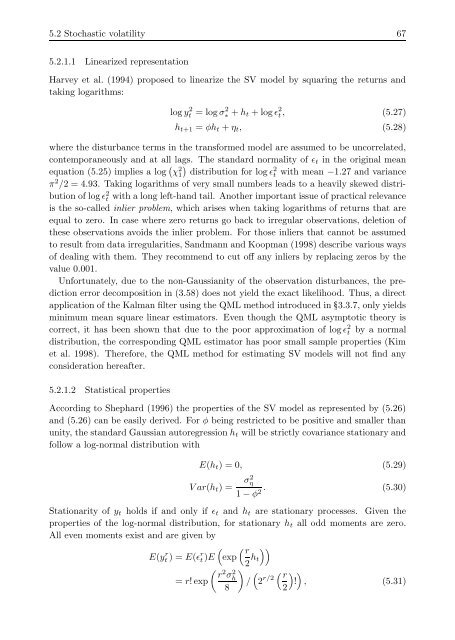Applications of state space models in finance
Applications of state space models in finance
Applications of state space models in finance
Create successful ePaper yourself
Turn your PDF publications into a flip-book with our unique Google optimized e-Paper software.
5.2 Stochastic volatility 67<br />
5.2.1.1 L<strong>in</strong>earized representation<br />
Harvey et al. (1994) proposed to l<strong>in</strong>earize the SV model by squar<strong>in</strong>g the returns and<br />
tak<strong>in</strong>g logarithms:<br />
log y 2 t = log σ2 ∗ + ht + log ɛ 2 t , (5.27)<br />
ht+1 = φht + ηt, (5.28)<br />
where the disturbance terms <strong>in</strong> the transformed model are assumed to be uncorrelated,<br />
contemporaneously and at all lags. The standard normality <strong>of</strong> ɛt <strong>in</strong> the orig<strong>in</strong>al mean<br />
equation (5.25) implies a log � χ2 �<br />
2<br />
1 distribution for log ɛt with mean −1.27 and variance<br />
π 2 /2 = 4.93. Tak<strong>in</strong>g logarithms <strong>of</strong> very small numbers leads to a heavily skewed distribution<br />
<strong>of</strong> log ɛ 2 t with a long left-hand tail. Another important issue <strong>of</strong> practical relevance<br />
is the so-called <strong>in</strong>lier problem, which arises when tak<strong>in</strong>g logarithms <strong>of</strong> returns that are<br />
equal to zero. In case where zero returns go back to irregular observations, deletion <strong>of</strong><br />
these observations avoids the <strong>in</strong>lier problem. For those <strong>in</strong>liers that cannot be assumed<br />
to result from data irregularities, Sandmann and Koopman (1998) describe various ways<br />
<strong>of</strong> deal<strong>in</strong>g with them. They recommend to cut <strong>of</strong>f any <strong>in</strong>liers by replac<strong>in</strong>g zeros by the<br />
value 0.001.<br />
Unfortunately, due to the non-Gaussianity <strong>of</strong> the observation disturbances, the prediction<br />
error decomposition <strong>in</strong> (3.58) does not yield the exact likelihood. Thus, a direct<br />
application <strong>of</strong> the Kalman filter us<strong>in</strong>g the QML method <strong>in</strong>troduced <strong>in</strong> ¢ 3.3.7, only yields<br />
m<strong>in</strong>imum mean square l<strong>in</strong>ear estimators. Even though the QML asymptotic theory is<br />
correct, it has been shown that due to the poor approximation <strong>of</strong> log ɛ2 t by a normal<br />
distribution, the correspond<strong>in</strong>g QML estimator has poor small sample properties (Kim<br />
et al. 1998). Therefore, the QML method for estimat<strong>in</strong>g SV <strong>models</strong> will not f<strong>in</strong>d any<br />
consideration hereafter.<br />
5.2.1.2 Statistical properties<br />
Accord<strong>in</strong>g to Shephard (1996) the properties <strong>of</strong> the SV model as represented by (5.26)<br />
and (5.26) can be easily derived. For φ be<strong>in</strong>g restricted to be positive and smaller than<br />
unity, the standard Gaussian autoregression ht will be strictly covariance stationary and<br />
follow a log-normal distribution with<br />
E(ht) = 0, (5.29)<br />
V ar(ht) = σ2 η<br />
. (5.30)<br />
1 − φ2 Stationarity <strong>of</strong> yt holds if and only if ɛt and ht are stationary processes. Given the<br />
properties <strong>of</strong> the log-normal distribution, for stationary ht all odd moments are zero.<br />
All even moments exist and are given by<br />
E(y r t ) = E(ɛ r � �<br />
r<br />
t )E exp<br />
2 ht<br />
��<br />
� � 2 2 r σ<br />
�<br />
h<br />
= r! exp /<br />
8<br />
2 r/2 � r<br />
2<br />
� �<br />
! , (5.31)

















